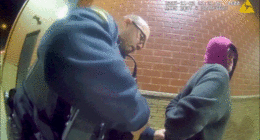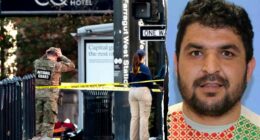Share this @internewscast.com
AIR India crash investigators believe an emergency power system kicked in – raising questions about whether the engines were working properly.
A raft of analysts now agree that a small turbine generator deployed as the Boeing 787 went down, after a “game-changer” video emerged.
In the days following the tragedy that claimed the lives of over 270 individuals, an HD video emerged showing a “protrusion on the belly of the aircraft” with a “tiny grey dot” below it.
Commentators say this was a system called Ram Access Turbine (RAT) poking out from the fuselage of the plane, which failed to climb more than 450ft.
Commercial airline pilot Steve Schreiber, also known as Captain Steve, clarified: “This feature is present on many airplanes. Located just behind the wing on the right side of the aircraft, there is a small door containing it.
“It looks like a little Evinrude motor, it’s a little two bladed prop.
“The purpose is to provide electrical and hydraulic pressure for the aircraft on an extreme emergency.”
Steve detailed that there are three potential causes for the RAT to deploy on a 787: “A significant electrical failure, a major hydraulic failure, or a dual engine failure.
“But I think the fact the aeroplane is mushing out the sky gives the idea it was a dual engine failure,” he said.
Other analysts agree that the RAT system deployed, and that the most likely cause was duel-engine failure.
Anthony Brickhouse, a US-based aerospace safety consultant, told the Wall Street Journal that the most common reason the propeller comes out is because the pilot thinks both engines have failed.
However, he reiterated this is highly unusual, telling the paper: “In commercial aviation, a dual engine failure is extremely rare.
“Our engines today are more efficient and reliable than ever.”
While there is growing consensus over the RAT deployment, investigators haven’t confirmed whether engine, hydraulic or other problems triggered the emergency system.
And it may be some time before we get an official diagnosis.
India’s Ministry of Civil Aviation said the accident remains under investigation and that more information would be provided in due course.
Air-accident investigations can take more than a year – and even then will often point to a number of contributing factors.
What is Ram Air Turbine?
A RAM Air Turbine, known as RAT, is a small wind turbine fitted into planes which generates power in the case of emergency.
It will deploy if the main engine stops generating power for any reason.
When activated, the small turbine stick out from below the wing or fuselage, and harnesses the wind power caused by the plane’s speed.
The airflow makes it spin round, in turn generating electricity which can be used.
This happens using a hydraulic pump or electrical generator linked up to the turbine.
A key feature of RAM is that is acts independently from the aircraft’s engine and other generation means, meaning it can in theory be used to create power even when the main systems go down.
Meanwhile, both of the black boxes have now been recovered.
One records flight data, such as altitude and speed, whilst the other monitors the cockpit sound.
The first was recovered from a rooftop near where the plane came down just 28 hours after the crash.
And the second is expected to reveal the pilots’ panic as the plane went down.
We already know that the pilot, Captain Sumeet Sabharwal, made a desperate mayday call to air traffic control in the moments before the disaster.
He cried out: “‘Thrust not achieved […] falling […] Mayday! Mayday! Mayday!”
The two pilots then wrestled for 17 seconds with the controls as the jet sank through the air before careening into the buildings below.
Sabharwal had 22 years of experience and had racked up 8,200 in the air.
The plane gained just a few hundred feet of altitude when the power apparently cut out, killing more Brits than any air disaster since 9/11.
Despite more than 270 people dying in the catastrophe, the pilot has been credited with saving “dozens of lives”.
Sabharwal diverted the jet at the last second to avoid slamming into a three-storey apartment building, according to locals on the ground.
All 18 families in the three-storey building under the flight path are convinced they owe their lives to Captain Sumeet Sabharwal.
He managed to divert the plane towards a patch of grassland.
The locals raced from their homes in Ahmedabad when a fireball from 90 tons of aviation fuel ignited as the plane slammed into the ground.
The aircraft obliterated the top two floors of a disused four-storey military building.
But the fire tore through the college’s hostel, killing dozens of students and staff who were having lunch in the canteen.
















